
Amazon Hikes FBA Fees Again: What This Means for Your Business
Steel yourselves, as Amazon decided to kickstart the holiday season by announcing updates to its FBA fees. 😫
In an announcement last week, Amazon said it will implement changes to its US FBA and referral fees. Most of the changes will be effective on the 17th of January next year, while two other changes will be in force on February 16 and April 1, 2023. Full updated fee guidelines are available here.
FBA Fees Just Keep Stacking Up
These increases on FBA seller fees, which we’ll go over in more detail shortly, are the latest in the Amazon Fee Stack, the name we’ve assigned to the company’s incremental but regular fee increases and which is not unlike fee stacking in the auction industry.
According to Amazon, some of the fee changes are the result of their observation that some sellers utilized more of their storage space than what they deemed necessary. This has consequently limited the amount of inventory that other sellers could ship to Amazon warehouses.
For that given reason, the eComm giant said it “will create additional granularity” (e.g., new weight tiers) in its FBA fees to “better align fees with our underlying costs.” Amazon itself has emphasized that they hope these fee increases will encourage an improvement in seller inventory health. This makes proper inventory forecasting and packaging optimization more important than ever.
For example, over-ordering or sending in unnecessarily large boxes, will hike up your FBA storage needs and fees. You might need to examine and change the way you manage your inventory if you want to keep your costs down next year.
Without further ado, here are the affected FBA fees, how much they will increase, and when they will take effect in 2023:
FBA Fulfillment Fees
Though we always expect FBA fee increases around this time, it’s always painful.
Big changes this year include Amazon getting rid of its on and off-peak fulfillment fees and instead combining both into one single fulfillment. Peak season fulfillment rates are only slightly lower whereas off-peak fees are generally considerably higher with at least $0.10 per unit increases in most cases.
Dimensional weight calculations still apply.
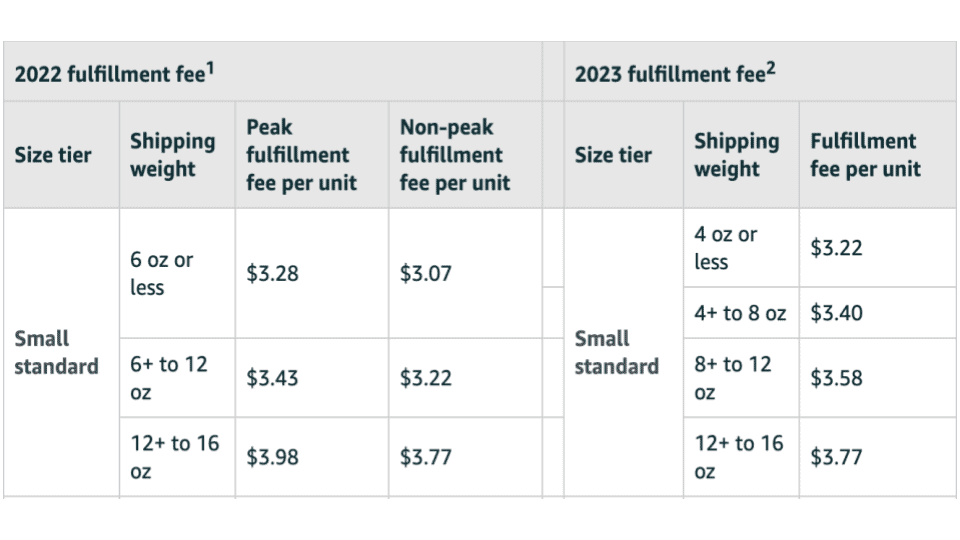
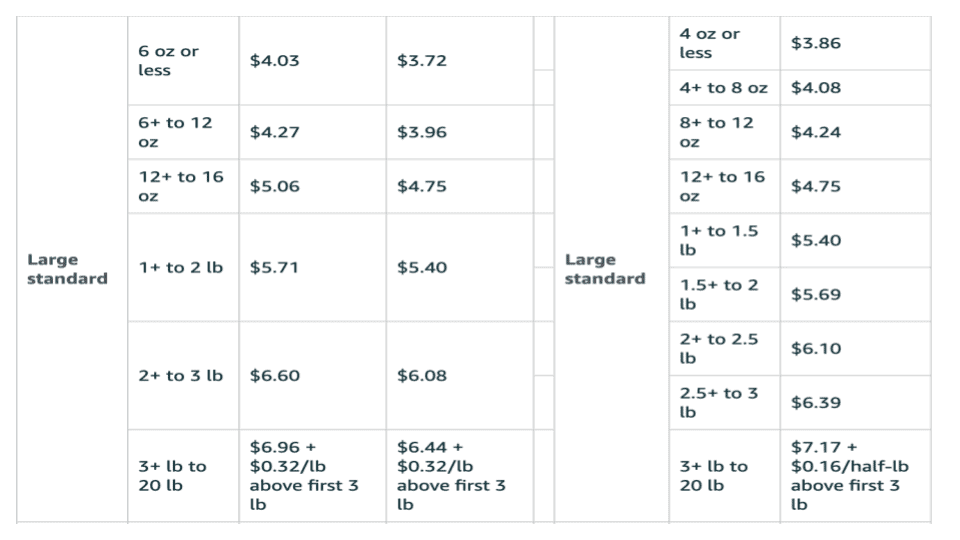
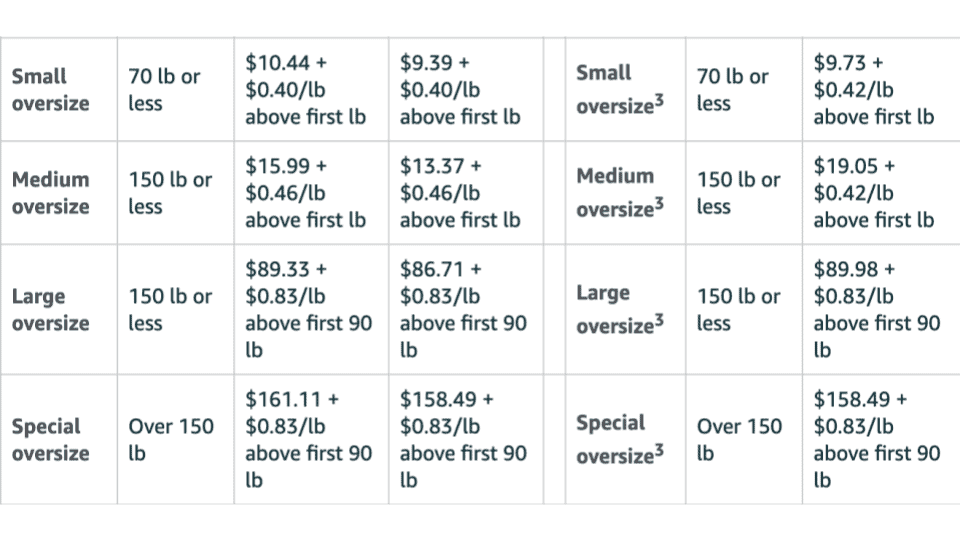
This year, we don’t get to wait until February to enjoy these fee increases as they take effect January 17, 2023.
Fuel and Inflation Surcharge
Technically speaking, Amazon did not increase its fuel & inflation surcharge, which it introduced on April 28th this year. What they did was to instead add it to their regular FBA fees permanently so there will no longer be a separate fuel & inflation surcharge.
Of course, we already knew that this surcharge wouldn’t be temporary, even though the company initially said so. History taught us that it’s almost impossible to withdraw a surcharge after it has already taken effect.
Since fuel costs and inflation rates have skyrocketed pretty much everywhere, Amazon increased their fulfillment costs and chose to call it a surcharge earlier to soften the blow that we ourselves knew would finally come. They, of course, announced its permanence in the holiday season when they can be sure most sellers are busy with Q4 sales and personal holiday activities.
⚠️ Sellers can (unfortunately) expect this permanent addition to their FBA costs beginning on January 17th.
$0.22 Average Increase in FBA Outbound Fees
Amazon was quick to point out that this increase is still lower than what other delivery and fulfillment partners offer. They also said they will come up with more specific weight tiers for the ¼ and ½ lb. categories (as shown below). Effective January 17th.
Use of Dimensional Weight Pricing for Large Standard-Size Apparel
Amazon first applied dimensional weight (DIM weight) pricing catalog-wide last year, excluding apparel.
Starting February 16, 2023, however, apparel goods that fall under the large standard-size tier (4 oz to 20 lbs) will now also be subject to DIM weight pricing, where the greater of unit weight or DIM weight will be used to determine the shipping weight for apparel.
Notice in the table of fees below that Amazon has indeed added new weight tiers to its 2023 fee structure: 4 oz or less, 4+ to 8 oz, and 1.5 lbs just to name a few. Shipping a 4 oz large standard-size apparel in 2023 would cost you $4.43 per unit, which was Amazon’s rate for items weighing 6 oz or less in 2022. This tier structure will be an improvement for some lighter products but will drive some heavier products into more expensive tiers at higher rates.
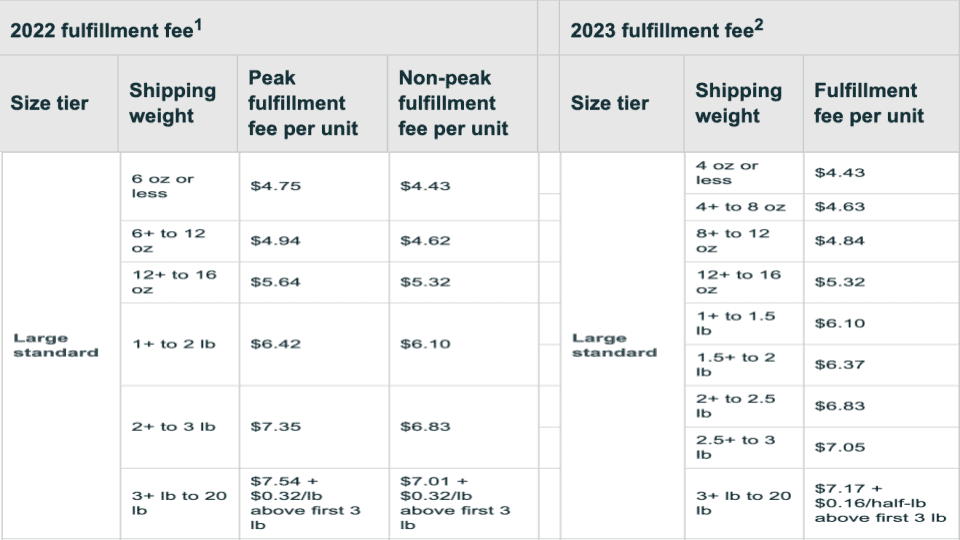
And when you apply DIM weight pricing, your shipping fees could get even more expensive.
Suppose your large standard-size apparel only weighs 16 oz, but the DIM weight is 1.5 lbs. In that case, you’re going to be charged $6.10 instead of $5.32/unit, a $0.78 difference.
If you haven’t done so already, try to keep your apparel packaging compact. Consider using vacuum bags to remove excess air that makes it bulky. Read Master Carton/Pallet Calculator for more packaging optimization tips.
$0.03 to $0.20 per Cubic Foot Increase for Storage Fees
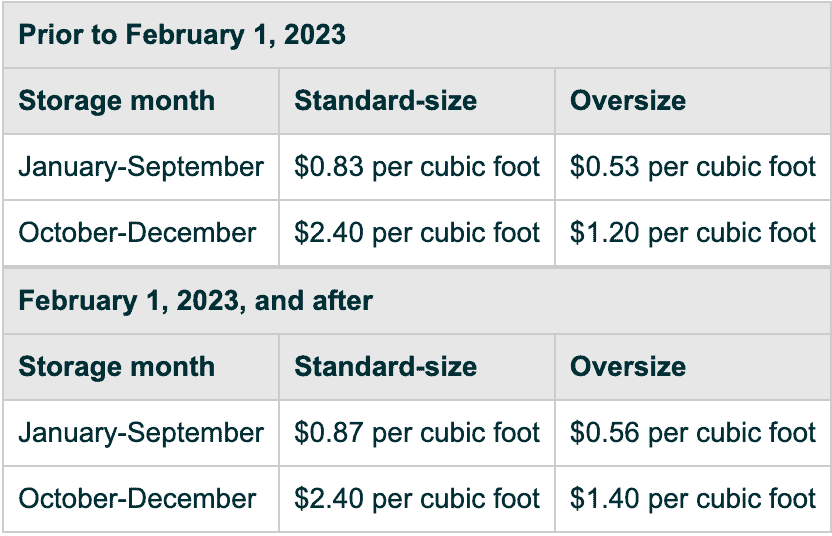
During the off-peak months of January to September, an extra $0.03 per cubic foot will be added for products under the oversized category, while those under the standard size category will be charged an extra $0.04 per cubic foot.
During the peak months of October to December, an additional $0.20 per cubic foot will be added for products in their non-sortable fulfillment centers (i.e., those holding huge and heavy items like furniture and large equipment). Effective January 17th.
New Storage Utilization Surcharge
Amazon said this only applies to sellers with large inventory cube sizes in their warehouses compared to their “recent weekly sales.”
⚠️ This is a big one! What this means is that you will now have a surcharge tied directly to your cubic sell-through. Amazon will look at your stored cubic feet against the daily average in cubic feet shipped over the trailing, past 13 weeks.
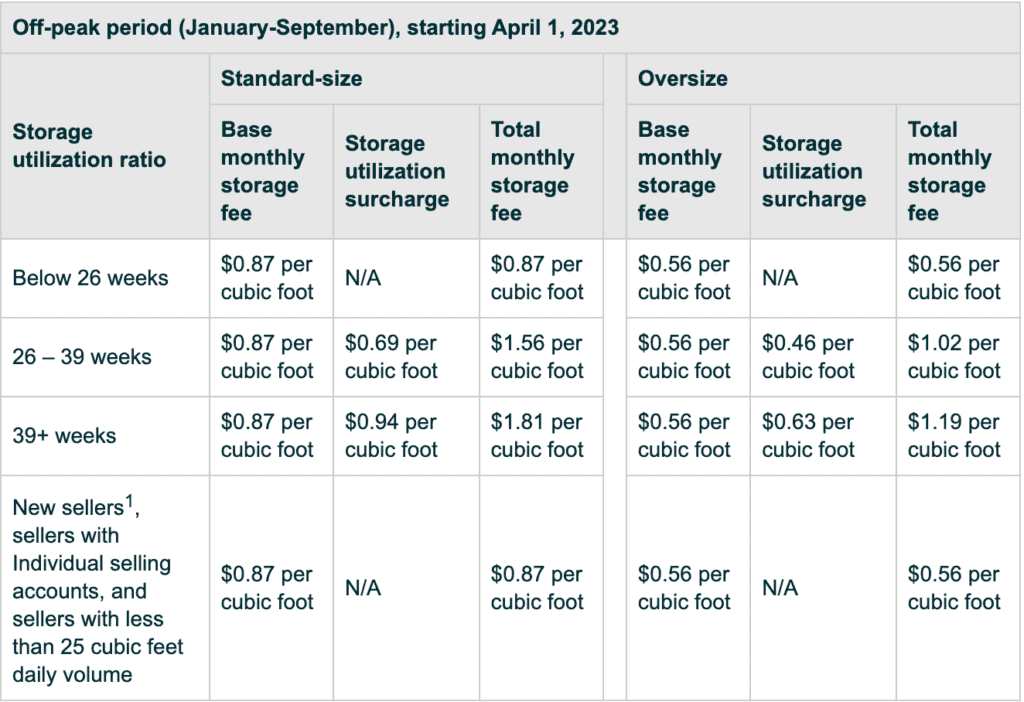
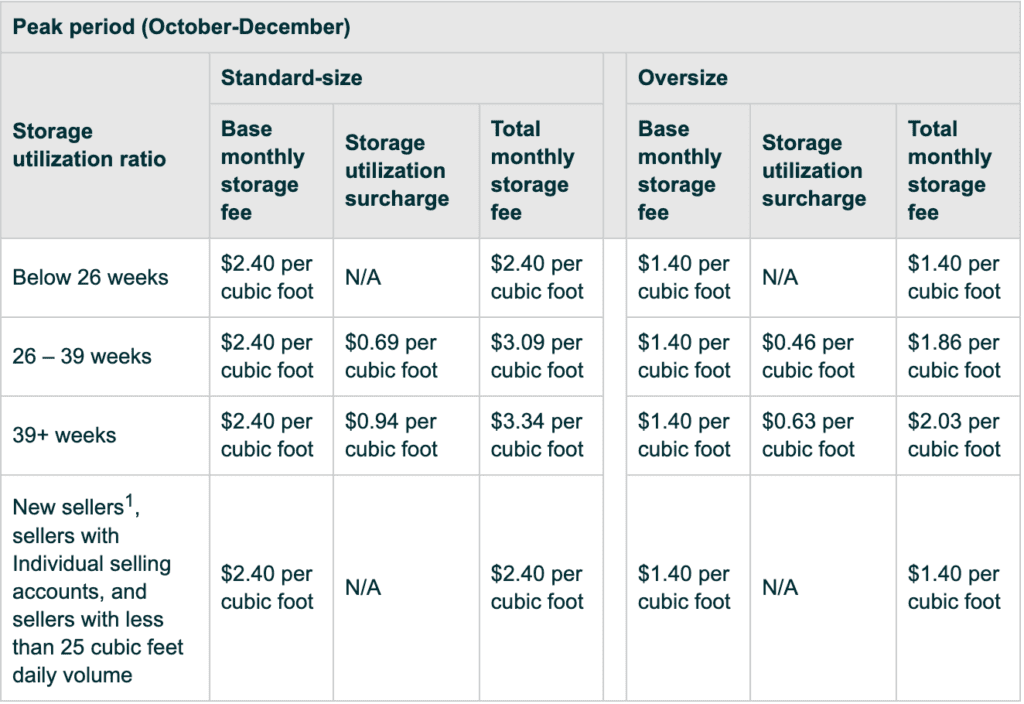
While the company gauged that around 7.5% sellers will be affected by this surcharge, it is something that all sellers need to be aware of as a slow in sales or too much overstocking can have a significant impact on your Amazon storage costs.
This surcharge will be effective on April 1st.
Aged Inventory Surcharges
Products stored in Amazon warehouses between 180-270 days will now be fined with an aged inventory surcharge. Additionally, existing surcharge rates will be increased for items stored between 271-365 days.
These adjustments apply to all product categories except for Apparel, Bags, Jewelry, Shoes, and Watches.
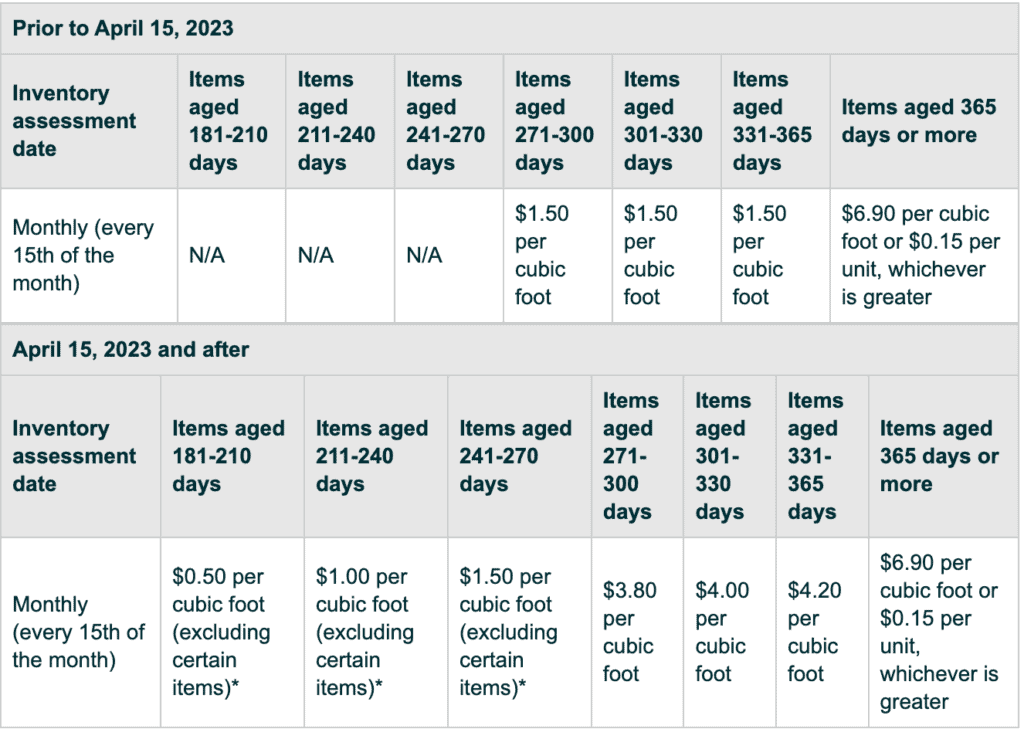
Fees increase every 30 days starting at $0.50 per cubic foot at the 180 day mark with a significant jump at 271 days increasing by 2.5x to $3.80/cubic foot, which is also 2.5x what it previously was in 2022.
Amazon claims these increases will boost efficiency and free up warehouse space for sellers who are able to maximize their storage space.
This change is effective for the April 15th aged inventory assessment period. Amazon encourages sellers to review their aging inventory and take the necessary measures.
Removal and Disposal Fees
Amazon said the rising costs of removing and disposing products led them to increase these fees.
Here’s what changed:
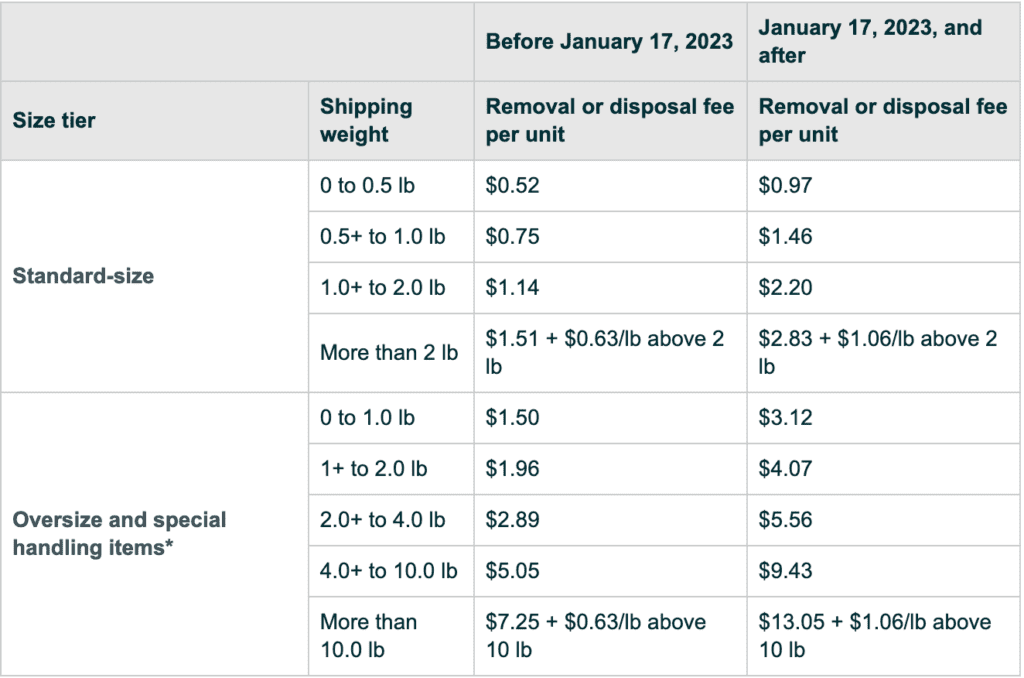
You’ll want to be prepared for significant fee increases by almost double for removal and disposal fees, effective January 17th.
Which Fees Went Down
The good news is that some FBA fees were adjusted in favor of the sellers’ profit margins. Here are the three FBA fees Amazon lowered and by how much:
$0.20 Average Decrease In Returns Processing Fee for Some Categories
Sellers of apparel and shoes can save an average of $0.20 per return when customers send back their purchased products. This does not apply to other product categories.
US FBA New Selection Program
Amazon made several attractive changes to its US FBA New Selection program, in a move that seems to encourage catalog growth through incentives for new-to-Amazon offerings.
Sellers will receive higher sales rebates – up to 10% on average from 5% – for qualified new parent ASINs. Amazon also doubled the number of eligible units from 50 to 100 per unit per parent ASIN and stretched the 90-day eligibility period for rebate and storage benefits to 120 days.
These changes will take effect in March 2023.
Related: Qualify for Rebates and Free Liquidations with the Updated FBA New Selection Program
Small and Light Program
Sellers can enjoy lower fees for more of their products after Amazon expands it to include items priced at $12 and below, up from its previous $10 mark. Effective January 17th.
Which Fees Stayed The Same
There is no movement on referral fees and liquidation fees.
Amazon also announced they will remove the Collectible fee categories, namely:
- Cards
- Coins
- Entertainment
- Sports
Affected ASINs will be reclassified to the most appropriate category, but there is a chance that sellers will be charged a higher (or lower) fee after they have been reclassified.
What This Means For Your Business
Amazon has a penchant for announcing price hikes and fee increases that significantly affect sellers’ margins, sometimes on short notice.
Unfortunately, we cannot predict which fee or surcharge they will introduce next time and when.
This is why sellers who want to run a profitable Amazon business need to be not only agile but also strategic.
Adapting quickly to changing storage needs, making accurate inventory forecasts, and right-sizing your packaging are more important than ever.
Given the increases in storage fees and aged inventory surcharges that Amazon will implement next year, sellers need to be very careful not to send excessive amounts of inventory to Amazon fulfillment centers.
What The FBA Sellers Are Saying
Many FBA sellers reacted negatively to this announcement and expressed their anger at Amazon for draining their diminishing profits (or what’s left of it).
Some sellers pointed out that the company already gets up to 40% of their sales because of these never-ending fees. A couple of sellers shared their frustration that their products were returned by customers because of “missed fulfillment promise” or because they were “delivered late by courier” but still, they are the ones absorbing the costs for Amazon’s failures.
Other sellers expressed their frustration that, as much as they want to increase the prices of their goods, they cannot because their product listings get deactivated due to high pricing errors.
Several sellers also raised the fact that because Amazon is laying off 10,000 of its employees and shutting down or subleasing several warehouses, there is a slim chance that things will improve in the near future.
For these reasons, some have started looking at other e-commerce platforms like Shopify and Walmart to ensure their business remains viable.
Related: Should You Be Selling on These New Sales Channels?, TikTok Gears Up for US Market Entry, eComm Players Dial Up Rivalry Ahead of the Holiday Season
Need more information?
- Send Message: We typically reply within 2 hours during office hours.
- Schedule Demo: Dive deeper into the nuances of our software with Chelsea.
- Join Live Upcoming Webinar: New to Amazon inventory management? Learn three inventory techniques you can implement right away.
 Get Started
Get Started